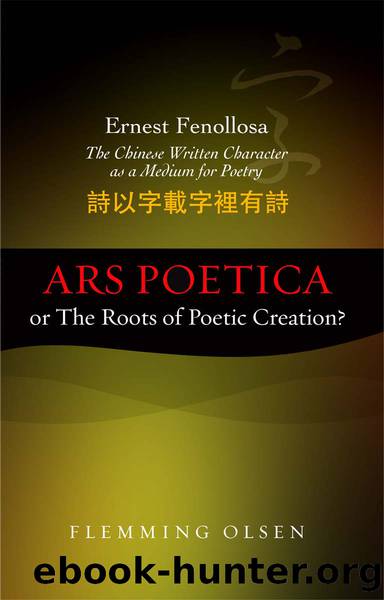Ernest Fenollosa -- the Chinese Written Character As a Medium for Poetry by Olsen Flemming;

Author:Olsen, Flemming;
Language: eng
Format: epub
Publisher: Liverpool University Press
Published: 2011-08-15T00:00:00+00:00
CONCLUDING REMARKS
Fenollosa despises classifications, but the pivot of his essay is the relation between two different categories, viz. the concrete and the abstract. Obviously much literature is based on that relation, sometimes in the form of the specific versus the general, as we see in the genre called the essay. A poetâs originality, it seems, consists in the extent to which he is able to exploit the movement between the two categories.
For all his interest in movement, Fenollosa does not take linguistic development into account. Changes, i.e. transitions, happen between the individual components of the language, but the language as a whole seems to have reached, or to be in, a state of stasis. The assumption is analogous to Saussureâs conception of âlangueâ. We are not told how new words or new concepts can be admitted to the system Fenollosa establishes.
Fenollosa takes the starting-point of his theories in the world of the senses, and few people would disagree with his assertion that a poetical picture increases, sometimes achieves, its impact by revealing its concrete origin. Fenollosa gives no examples from English literature, but what we call metaphor â as we have seen, Fenollosa uses the word in an idiosyncratic and pervasive sense â is a semantic anomaly in that it conveys an abstract meaning in terms of a concrete formulation, as when Stephen Spender says that âthe furniture carries cargoes of meaningâ.1
When Fenollosa talks about ascent from concrete to abstract, we would perhaps tend to call it a juxtaposition resulting from a semantic and notional leap. However, his choice of the word âascentâ shows that he considered the rootedness of the picture in the concrete significant because, as he saw it, it was closer to ârealityâ. That, of course, enhanced the prestige of poetry and bade defiance to science, which claimed to have a monopoly of describing reality. That same defiance is the raison dâêtre of the Imagist movement. At the same time Fenollosa postulates an upward movement away from the concrete.
We may illustrate Fenollosaâs point with a quotation from Macbeth (I, iv, 28 et seq.), where Shakespeare shows how abstract ideas like friendship, empathy and loyalty can be expressed in terms taken from the cycle of nature. King Duncan speaks first to Macbeth, then to Banquo:
I have begun to plant thee, and will labour
to make thee full of growing. Noble Banquo
that has no less deserved, nor must be known
no less to have done so; let me infold thee,
and hold thee to my heart.
To which Banquo answers,
Here if I grow,
the harvest is your own.
Surely that is pithier than for one participant in a dialogue to say, âIâve taken an interest in you, and Iâll help you forward,â and for the other to answer, âIf I succeed, itâs thanks to youâ.
The Chinese Written Character as a Medium for Poetry is in several respects a peculiar piece of writing. The supporting pillar of the text â and that which made it popular and influential in its day â is the authorâs insistence on the role of the image in poetry.
Download
This site does not store any files on its server. We only index and link to content provided by other sites. Please contact the content providers to delete copyright contents if any and email us, we'll remove relevant links or contents immediately.
4 3 2 1: A Novel by Paul Auster(11075)
The handmaid's tale by Margaret Atwood(6875)
Giovanni's Room by James Baldwin(5896)
Big Magic: Creative Living Beyond Fear by Elizabeth Gilbert(4736)
Asking the Right Questions: A Guide to Critical Thinking by M. Neil Browne & Stuart M. Keeley(4600)
On Writing A Memoir of the Craft by Stephen King(4221)
Ego Is the Enemy by Ryan Holiday(4003)
Ken Follett - World without end by Ken Follett(3984)
The Body: A Guide for Occupants by Bill Bryson(3816)
Bluets by Maggie Nelson(3724)
Adulting by Kelly Williams Brown(3681)
Guilty Pleasures by Laurell K Hamilton(3601)
Eat That Frog! by Brian Tracy(3527)
White Noise - A Novel by Don DeLillo(3443)
The Poetry of Pablo Neruda by Pablo Neruda(3372)
Alive: The Story of the Andes Survivors by Piers Paul Read(3320)
The Bookshop by Penelope Fitzgerald(3237)
The Book of Joy by Dalai Lama(3236)
Fingerprints of the Gods by Graham Hancock(3223)
